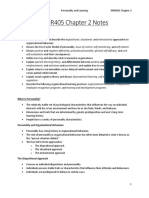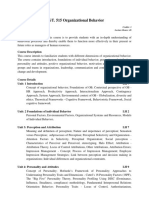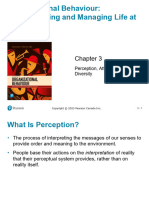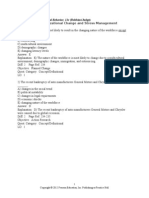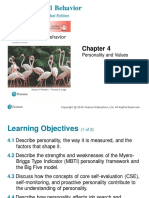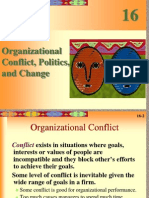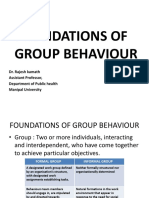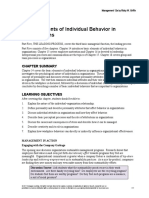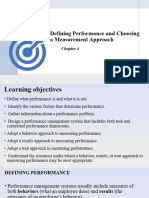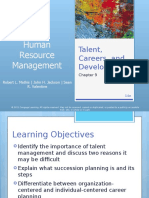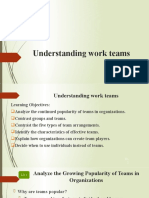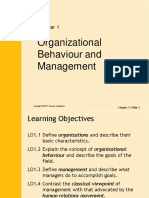Syed Ahad Rizvi Intro to Organizational Behaviour and Management MHR405 Chapter 1
MHR405 Chapter 1 Notes
Learning Objectives
Define organizations and describe their basic characteristics.
Explain the concept or organizational behaviour and describe the goals of the field.
Define management and describe what managers do to accomplish goals.
Contrast the classical viewpoint of management with that advocated by the human relations
movement.
Describe the contingency approach to management.
Explain what managers do – their roles, activities, agendas for action, and thought processes.
Describe the four contemporary management concerns facing organizations and how
organizational behaviour can help organizations understand and manage these concerns.
What Are Organizations?
Organizations are social inventions for accomplishing common goals through group effort.
Key characteristics or organizations:
o Social inventions
o Goal accomplishment
o Group effort
Social inventions
An essential characteristic of organizations is the coordinated presence of people, not things.
The field of organizational behaviour is about understanding people and managing them to work
effectively.
Goal accomplishment
All organizations have goals.
Organizational survival and adaptation to change are important goals.
The fields of organizational behaviour is concerned with how organizations can survive and
adapt to change.
Certain behaviours are necessary for survival and adaptation.
Innovation and flexibility are especially important for organizations.
Group Effort
Organizations are based on group effort – the interaction and coordination among people to
accomplish goals.
Much of the intellectual and physical work done in organizations is performed by groups.
The field of organizational behaviour is concerned with how to get people to practice effective
teamwork.
1
�Syed Ahad Rizvi Intro to Organizational Behaviour and Management MHR405 Chapter 1
What is Organizational Behaviour?
The attitudes and behaviours of individuals and groups in organizations.
How organizations can be structured more effectively.
How events in the external environment affect organizations.
What Is Humans Resources Management?
Programs, practices, and systems to acquire, develop, motivate, and retain employees in
organizations.
Recruitment, selection, compensation, and training and development are common human
resources practices.
Knowledge or organizational behaviour will help you understand the use and effectiveness or
human resource practices.
Why Study Organizational Behaviour?
Organizational behaviour:
o Is interesting. It is about people and human nature and explains the success and failure
or organizations.
o Is important. It has a profound impact on managers, employees, and consumers.
o Makes a difference. It affects individuals’ attitudes and behaviour as well as the
competitiveness and effectiveness or organizations.
Human capital
Social capital
Management Practices of the Best Companies to Work for in Canada
Flexible work schedules.
Stock-options, profit -sharing, and bonuses.
Opportunities for learning and development.
Family assistance programs.
Career development programs.
Wellness and stress reduction programs.
Employee recognition and reward programs.
Goals of Organizational Behaviour
The field of organizational behaviour has three commonly agreed-upon goals:
o Predicting organizational behaviour and events.
o Explaining organizational behaviour and events in organizations.
o Managing organizational behavior.
2
�Syed Ahad Rizvi Intro to Organizational Behaviour and Management MHR405 Chapter 1
Predicting Organizational Behaviour
In organizations, there is considerable interest in predicting when people will make ethical
decisions, create innovative products, or engage in sexual harassment.
Through systematic study, the field of organizational behaviour provides a scientific foundation
that helps improve predictions or organizational events.
Explaining Organizational Behaviour
Organizational behaviour is interested in determining why people are more or less motivated,
satisfied, or prone to resign.
The ability to understand behaviour is a necessary prerequisite for effectively managing it.
Managing Organizational Behaviour
Management is the art of getting things accomplished in organizations through others.
If behaviour can be predicted and explained, it can often be managed.
Predictions and explanation involves analysis while management is about action.
Effective management involves evidence-based management.
Evidence-Based Management
Involves translating principles based on the best scientific evidence into organizational practices.
Making decisions based on the best available scientific evidence from social science and
organizational research rather than personal preference and unsystematic experience.
The use of evidence-based management is more likely to result in the attainment of
organizational goals.
Early Prescriptions Concerning Management
Attempts to prescribe the “correct” way to manage an organization and achieve its goals.
Two basic phases to this prescription:
o The classical view and bureaucracy
o The human relations view
The Classical View
The classical view advocates a high degree of specialization of labour, intensive coordination,
and centralized decision making.
To maintain control, it suggest that managers have fairly few workers, except for lower-level
jobs where machine pacing might substitute for close supervision.
3
�Syed Ahad Rizvi Intro to Organizational Behaviour and Management MHR405 Chapter 1
Scientific Management
Scientific management is Frederick’s Taylor’s system for using research to determine the
optimum degree of specialization and standardization of work tasks.
Mainly concerned with job design and the structure of work on the shop floor.
Involves the use of research to determine the optimum degree of specialization and
standardization.
Bureaucracy
Bureaucracy is Max Weber’s ideal type of organization that includes:
o Strict chain of command
o Selection and promotion criteria based on technical competence
o Detailed rules, regulations, and procedures
o High specialization
o Centralization of power at the top of the organization
Weber saw bureaucracy as an “ideal type” that would standardize behaviour in organizations
and provide workers with security and a sense of purpose.
The classical view of management seemed to take for granted an essential conflict of interest
between managers and employees.
The Human Relations Movement and a Critique of Bureaucracy
The human relations movement began with the famous Hawthorne Studies of the 1920s and
1930s conducted at the Hawthorne plant of Western Electric
The Hawthorne Studies
Concerned with the impact of fatigue, rest pauses, and lighting on employee productivity.
The studies illustrated how psychological and social process affect productivity and work
adjustment.
Suggest there could be dysfunctional aspects to how work was organized.
One sign was resistance to management through strong informal group mechanisms such as
norms that limited productivity.
Critique of Bureaucracy
The human relations movement called attention to certain dysfunctional aspects of classical
management and bureaucracy and noted several problems:
o Employee alienation
o Limits innovation and adaptation
o Resistance to chance
o Minimum acceptable level of performance
o Employees lose sight of the overall goals of the organization
4
�Syed Ahad Rizvi Intro to Organizational Behaviour and Management MHR405 Chapter 1
The Human Relations Movement
Advocated more people-oriented and participative styles of management that catered more to
the social and psychological needs of employees.
The movement called for:
o More flexible systems of management
o The design of more interesting jobs
o Open communication
o Employee participation
o Less rigid, more decentralized forms of control
Contemporary Management – The Contingency Approach
The merits of both approaches are recognized today.
Management approaches need to be tailored to fit the situation.
The complexity of human behaviour means that an organizational behaviour text cannot be a
“cookbook”.
The general answer to many of the problems in organizations is: “It depends.”
Dependencies are called contingencies.
The contingency approach to management recognizes that there is no one best way to manage.
An appropriate management style depends on the demands of the situation.
What Do Managers Do?
The field of organizational behaviour is concerned with what happens in organizations and what
managers actually do in organizations.
Research has focuses on:
o Managerial roles
o Managerial activities
o Managerial agendas
o Managerial minds
o International managers
Managerial Roles
Henry Mintzberg discovered a rather complex set of roles played by managers:
o Interpersonal roles – Have to do with establishing and maintaining interpersonal
relations. Include figurehead, leadership, and liaison roles.
o Informational roles – Are concerned with various ways managers receive and transmit
information. Include monitor, disseminator, and spokesperson roles.
5
�Syed Ahad Rizvi Intro to Organizational Behaviour and Management MHR405 Chapter 1
o Decisional roles – Deal with decision making. Include entrepreneur, disturbance,
resource allocation, and negotiator roles.
Managerial Activities
Fred Luthans, Richard Hodgetts, and Stuart Rosenkrantz found that managers engage in four
basic types of activities”
o Routine communication (formal sending and receiving information)
o Traditional management (planning, decision making, controlling)
o Networking (interaction with people outside of the organization)
o Human resource management (motivating, reinforcing, disciplining, punishing,
managing conflict, staffing, training, and developing employees)
All these managerial activities involve dealing with people.
Managerial Activities and Success
Emphasis on these various activities is related to managerial success.
Networking is related to moving up the ranks of the organization quickly.
Human resource management is related to employee satisfaction and commitment and unit
effectiveness.
Managerial Agendas
John Kotter studies the behaviour patterns of successful general managers and identified the
following categories of behaviour:
o Agenda setting
o Networking
o Agenda implementation
A high degree of informal interaction and concern with people issues that were necessary for
the managers to achieve their agendas.
Managers often found themselves dependent on people over whom they wielded no power.
Agenda Setting
What they wanted to accomplish for the organization.
6
�Syed Ahad Rizvi Intro to Organizational Behaviour and Management MHR405 Chapter 1
Almost always informal and unwritten and concerned with “people issues”.
Agendas based on wide-ranging informal discussions with a wide variety of people.
Networking
Established a wide formal and informal network of key people inside and outside of their
organization.
The network provides managers with information and established cooperative relationships
relevant to their agendas.
Agenda Implementation
Managers used networks to implement the agendas.
They would go anywhere in the network for help.
They employed a wide range of influence tactics.
Managerial Minds
Herbert Simon and Daniel Isenberg explored how manager’s think.
Experienced managers use intuition to guide many of their actions:
o To sense that a problem exists
o To perform well-learned mental tasks rapidly
o To synthesize isolated pieces of information and data
o To double-check more formal or mechanical analyses
Good intuition is problem identification and problem solving based on a long history of
systematic education and experience.
Enables the manager to locate problems within a network of previously acquired information.
International Managers
The style in which managers do what they do and the emphasis they give to various activities
will vary greatly across cultures.
Cultural variations in values affect both managers’ and employees’ expectations about
interpersonal interaction.
Geert Hofstede showed how cross-cultural difference in values leads to contrasts in the general
role that managers play across cultures.
National culture is one the more important contingency variables in organizational behaviour.
The appropriateness of various leadership styles, motivation techniques, and communication
methods depends on where one is in the world.
7
�Syed Ahad Rizvi Intro to Organizational Behaviour and Management MHR405 Chapter 1
Some Contemporary Management Concerns
Four issues which organizations and managers are currently concerned:
o Diversity – Local and Global
o Employee Health and Well-being
o Talent Management and Employee Engagement
o Corporate Social Responsibility (CSR)
Diversity – Local and Global
The Canadian workforce is becoming increasingly culturally diverse.
Many organizations have not treated certain segments of the population fairly in many aspects
of employment.
Global business has increased and so has the need to understand how workers and customers in
other countries are diverse and culturally different.
What does diversity have to do with organizational behaviour?
Organizational behaviour is concerned with issues that have to do with the management of a
diverse workforce and how to benefit from the opportunities that a diverse workforce provides.
Employee Health and Well-Being
Increased concerns over job security, increasing job demands, and work-related stress.
Absenteeism and turnover are on the rise.
Increasing stress levels and poorly designed jobs are major causes.
Negative effect on employee physical and psychological health and well-being.
Work-life conflict is a major stressor and cause of absenteeism.
Increasing awareness of mental health problems in the workplace.
Organizations have begun to focus on mental health and to create more positive work
environments.
What does employee health and well-being have to do with organizational behaviour?
Organizational behaviour is concerned with creating positive work environments that contribute
to employee health and wellness.
Many organizations are now focusing on creating a psychologically healthy workplace.
Healthy and Productive Work Environment
Practices that create a psychologically healthy and productive work environment:
o Employee involvement
o Health and safety
o Employee growth and development
o Work-life balance
o Employee recognition
Communication is also important and is the foundation for the five psychologically healthy
workplace practices.
8
�Syed Ahad Rizvi Intro to Organizational Behaviour and Management MHR405 Chapter 1
Workplace Spirituality
Workplace spirituality refers to workplaces that provide employees with meaning, purpose, a
sense of community, and a connection to others.
It is about providing employees with a meaningful work-life that is aligned with their values.
Employees have opportunities for personal growth and development, and they feel values and
supported.
Positive Organizational Behaviour
The study and application of positively oriented human resource strengths and psychological
capacities that can be measured, developed, and effectively managed for performance
improvement.
The psychological capacities that can be developed in employees are known as psychological
capital or PsyCap.
Psychological Capital (PsyCap)
An individual’s positive psychological state of development that is characterized by
o Self-efficacy – One’s confidence to take on and put in the necessary effort to succeed at
challenging tasks.
o Optimism – Involves making internal attribution about positive events in the present
and future and external attributions about negative events.
o Hope – Persevering toward one’s goals, and when necessary making changes and using
multiple pathways to achieve one’s goals.
o Resilience – One’s ability to bounce back or rebound from adversity and setbacks to
attain success.
Each of the components of PsyCap are states not traits; they are positive work-related
psychological resources that can be changes, modified, and developed.
PsyCap is positively related to employee and well-being, job attitudes, and job performance, and
negatively related to employee anxiety, stress, and turnover intentions.
PsyCap interventions (PCI) can be used to develop employees’ PsyCap.
9
�Syed Ahad Rizvi Intro to Organizational Behaviour and Management MHR405 Chapter 1
Organizations can improve employee health and well0being developing employees’ PsyCap.
Talent Management and Employee Engagement
Talent management refers to an organization’s processes for attracting, developing, retaining,
and deploying people with the required skills to meet current and future business needs.
The management of talent has become a major organizational concern that requires the
involvement of all levels of management.
Work engagement refers to a positive work-related state of mind that is characterized by vigour,
dedication, and absorption.
It has been reported that only one-third of workers are engaged.
Engaged workers have more positive job attitudes and higher job performance.
Employee engagement is considered to be key to an organization’s success and
competitiveness.
What does talent management and employee engagement have to do with organizational
behaviour?
Organizational behaviour provides the means for organizations to be designed and managed in
ways that optimize the attraction, development, retention, engagement, and performance of
talent.
Corporate Social Responsibility
Corporate social responsibility (CSR) refers to an organization taking responsibility for the impact
of its decisions and actions on its stakeholders.
It extends beyond the interest of shareholders to the interests and needs of employees and the
community in which it operates.
External CSR: Practices aimed at the local community, the environment, and consumers.
Internal CSR: Practices and activities that are focused on the internal workforce.
What does a focus on social responsibility have to do with organizational behaviours?
Many CSR issues have to do with organizational behaviour (e.g., treatment of employees, work-
family balance, employee well-being).
CSR also involves environmental, social, and governance (ESG) issues, and a concern for the
environment and green initiatives.
An organization’s CSR activities are policies are associated with financial performance as well as
employee attitudes, engagement, and performance.
CSR also has implications for the recruitment and retention of employees.
Organizational behaviour can help organizations become more socially responsible.
Summary and Road Map
Organizational behaviour involves three levels of analysis: the individual level, the group level,
and the organizational level.
The factors within each level influence individual and group attitudes and behaviours.
Each level can influence the factors and processes at the other levels.
All three levels of organizational behaviour as well as individual and group attitudes and
behaviours influence organizational performance.
10
�Syed Ahad Rizvi Intro to Organizational Behaviour and Management MHR405 Chapter 1
11
